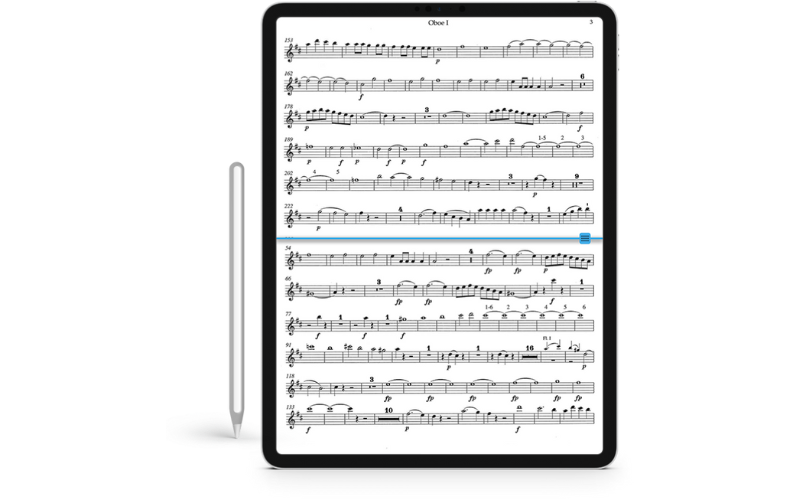Scales in music: everything you need to know
The word "scale" can evoke a variety of reactions from musicians and music students alike: a chore for some, familiar territory for others, or a mystery to be unraveled for those new to music theory. And yet, scales remain an essential part of music, for beginners and experienced musicians alike.
So what is scale ? Why do we speak of scale major and scale minor? What's the difference between a relative, pentatonic, blues, melodic or harmonicscale ? What role do scales play in the construction of a piece of music? Tones, semitones and intervals: we give you the (G) key to unlock all the secrets of scales!
Scales in music: what are we talking about?
What is scale ?
Scales are ordered sets of notes that define the tonal space in which a composition evolves. They provide the melodic and harmonic framework for a piece of music. A scale can be compared to a series of stairs, with each step representing a note, forming an ascending or descending sequence.
In music, scales provide the foundation on which melodies, harmonies and rhythms are built. They enable musicians to express emotions and create a specific atmosphere. Scales are used to compose melodies, create chord progressions and improvise, forming an integral part of the creative process in many musical genres.
The construction of a scale is based on a series of predefined intervals, such as tones and semitones, which determine the distances between notes. Scales can vary according to their interval structure, giving them unique sound characteristics. In addition to major and minor scales, other types of scale exist, each with its own particularities.
The components of scale : tones, semitones and intervals
Scales are made up of different distances between notes, called tones and semitones. A tone represents a harmonic distance between two notes, equivalent to two semitones. More precisely, it takes a diatonic halftone and a chromatic halftone to form a tone.
A diatonic halftone is the smallest distance between two consecutive notes in a natural musical scale, i.e. an interval of half atone on a piano keyboard, or a fret on a guitar. On the other hand, a chromatic halftone corresponds to the smallest distance between two consecutive notes, whether diatonic or not, such as the passage from a C to a C sharp or D flat. On a piano, this would correspond to playing a black key immediately to the right or left of its neighboring white key.
tone and halftone
A scale major consists of a specific sequence of tones and semitones. For example, in the scale of C major, the distance between C and D is one tone, while the distance between E and F is a halftone.
Let's take a look at scale in natural A minor. This scale begins with a tone between the tonic (the starting note) and the second note, then a halftone between the second and third notes, and so on. For example, in the scale of natural A minor, the distance between A and B is one tone, while the distance between D and E is halftone.
In addition to tones and semitones, scales are defined by their intervals. Intervals measure the distance between two notes and determine the melodic and harmonic structure of scale. Each type of scale has its own interval pattern. The scale major is characterized by a major third between the first and third notes, while the scale natural minor has a minor third between these same notes.
Major scales
What is a scale major?
A scale major is a specific sequence of notes arranged in an interval pattern that creates a bright, happy atmosphere. It is often used to express positive emotions in music. There are twelve major scales, one for each note of the scale chromatic scale, divided into two types: major scales with a sharp and those with a flat.
Each scale major has its own sequence of notes, but all follow the same interval pattern.
The scale major also features 7 modes: Ionian, Dorian, Phrygian, Lydian, Mixolydian, Aeolian and Locrian.
How to build a scale major?
The construction of a scale major follows a well-defined formula, which can be applied to any starting note: tone- tone-demi- tone- tone- tone- tone-demi- tone. Depending on the first note chosen to build a scale major, it may be necessary to add sharps or flats to obtain the desired structure.
Alterations, such as flats (♭) and sharps (♯), are used to change the pitch of a note by half atone up (sharp) or down (flat).
For example, if we start from the note C, we obtain the scale of C major by following this formula. If we start from the note F, which is located half atone below C, we'll need to add a flat to our scale to maintain the interval pattern of the scale major**.** Thus, we obtain the scale of F major with a flat on the note B.
scale of C major
Minor scales
What is a scale minor?
The scale minor offers a palette of darker, more melancholy emotions, contrasting with the optimism of the scale major. There are 3 categories of minor scales:
The scale natural minor (the most common),
the scale harmonic minor,
the scale melodic minor.
The scale minor is a specific sequence of notes arranged in a pattern of intervals that creates a darker, more introspective atmosphere. It is often used to express emotions such as sadness, melancholy or nostalgia in music.
How to build a scale minor?
Unlike the scale major, which has a brighter, more cheerful sound, the scale minor is imbued with a darker, more introspective atmosphere. This pattern of intervals, made up of tones and semitones, lends scale its harmonic richness.
To construct a scale minor, a precise interval pattern is used: tone-demi- tone- tone- tone-demi- tone- tone. This pattern creates a harmonic sequence that conveys the emotion of the scale minor. Starting with any starting note, this pattern can be followed to build a scale minor in any tonality.
scale of C minor
Other scales found in music
In addition to major and minor scales, other scales exist, each with its own characteristics and sonorities.
The scale pentatonic
Pentatonic scales are five-note scales commonly used in many musical cultures around the world. Their simplicity and versatility make them particularly interesting for improvisation and composition.
Pentatonic scales are often associated with exotic or meditative moods, and are widely used in blues, rock, traditional Chinese music and many other styles.
Modal scales
Modal scales are a set of scales that differ from traditional major and minor scales. Each mode has its own interval pattern. For example, the Dorian mode is often associated with mysterious, evocative sounds, while the Lydian mode evokes a sense of luminosity and space. Modal scales have been widely used in early music, but they also continue to inspire contemporary composers.
Thechromatic range
Chromatic scales comprise all the notes of the scale musical scale, including semitones. They offer a rich, complex sound and are often used to create dissonance and harmonic tension in contemporary music.
La scale blues
The scale blues is mainly used in blues music and related genres. It is characterized by the addition of altered notes such as the diminished fifth and the minor seventh. The scale blues in E is used in many famous blues songs.
The scale harmonic
The scale harmonic is based on the natural harmonics of music and is often used to create mysterious atmospheres. For example, the harmonic scale of A minor is often used in classical music and certain forms of world music.
Relative ranges
Relative scales are pairs of major and minor scales that share the same accidentals but start on different notes. For example, the scale of G major and G minor:
The scale of G major: This scale is built from the note G as tonic and follows the interval pattern tone-tone-demi-tone-tone-tone-demi-tone. Thus, the scale of G major includes the notes G, A, B, C, D, E, F♯ and G.
The scale of G minor: This scale is built from the note G as tonic and follows the interval pattern tone-demi-tone-tone-tone-demi-tone-tone. Consequently, the scale of G minor includes the notes G, A, B♭, C, D, E♭, F and G.
These two scales use the same tonic (the note G) but have different interval structures.
The scale altered
Altered scales are scales that contain altered notes, i.e. notes that are augmented or diminished in relation to the natural scale . They are often used in jazz and contemporary music to create dissonance and harmonic tension. The altered E scale is often used injazz improvisation to create complex melodic lines.
The scale symmetrical
Symmetrical scales are scales that follow a symmetrical pattern in their construction. They are characterized by a regular repetition of melodic or harmonic motifs.
♫ Are you a musician who's tired of misplacing your sheet music everywhere? Thanks to the Sheet music reader Newzikyou'll find all your sheet music in one place, wherever you want. Whether you're in music class, at a distance or rehearsing, you can share your scores with other musicians in real time. With Newzik, there's no excuse not to work on your scales when you're on vacation!








